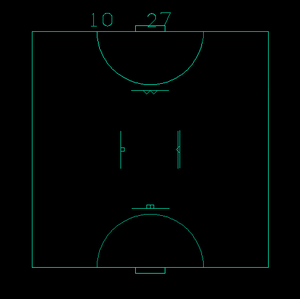Difference between revisions of "Dazzle Dart"
(Add picture.) |
m (New category) |
||
| (11 intermediate revisions by 2 users not shown) | |||
| Line 1: | Line 1: | ||
| − | [[Image:Daz.png|300px|rightt|thumb|Dazzle Dart]] | + | [[Image:Daz-screenshot.png|300px|rightt|thumb|Dazzle Dart]] |
| − | + | '''Dazzle Dart''' was a [[video game]] created in the mid 70s by Hal Abelson, Nat Goodman, and Andrea diSessa, inspired by the short story Bullard Reflects by Malcolm Jameson. | |
| − | The first version ran on the MIT LOGO group [[PDP-11/45]]. It used a [[vector display]] made by Tom Knight. | + | The first version ran on the MIT [[LOGO]] group [[PDP-11/45]]. It used a [[vector display]] made by Tom Knight. |
| − | It was ported to the AI lab [[PDP-6]] and [[Type 340 Display]] by Ken Harrenstien and Charles Frankston. | + | It was ported to the [[MIT Artificial Intelligence Laboratory|AI lab]] [[PDP-6]] and [[Type 340 Display]] by Ken Harrenstien and Charles Frankston. |
| − | Source code for both versions were recovered in May 2018, thanks to Hal Abelson and Ken Harrenstien. | + | [[Source code]] for both versions were recovered in May 2018, thanks to Hal Abelson and Ken Harrenstien. |
| − | The [[PDP-11]] version | + | The [[PDP-11]] version runs on the [[SIMH]] PDP-11 [[emulator]] which includes support for the TK display. The PDP-6 version runs on Richard Cornwell's [[KA10]] emulator. |
| + | |||
| + | The game is played with two teams pitted against each other. Each team has two players. Players can move around on the field, except inside the semi circles around the goals, and rotate. One player at a time has the ability to shoot a beam. To score, the beam has to reflect at least once - against a wall or another player - and enter the goal. A team has 30 seconds to make a goal, or else the beam is passed over to the other team. | ||
==External Links== | ==External Links== | ||
| − | * [http://www.kaleberg.com/dazzle/dazzle.html Dazzle Darts - A Lost Computer Game of the 1970s] | + | * [https://github.com/pdp11/Dazzle-Dart/ Dazzle Dart source code]. |
| + | * [http://www.kaleberg.com/dazzle/dazzle.html Dazzle Darts - A Lost Computer Game of the 1970s] by Seth Steinberg. | ||
| + | * [https://dl.acm.org/doi/10.1145/1216479.1216482 Dazzle dart: reflections on computer games] by Hal Abelson. ([https://github.com/PDP-10/Dazzle-Dart/blob/master/HAL%3B%20DAZZL%20DART Article source.]) | ||
| + | * [https://dspace.mit.edu/handle/1721.1/5787 Logo Progress Report 1973-1975 (AI memo 356)], section 2.5.2. | ||
| + | * [https://www.osa-opn.org/home/articles/volume_18/issue_10/departments/light_touch/playing_with_light_a_history_of_games_that_incorp/ Playing With Light] by Stephen R. Wilk. | ||
| − | + | [[Category: Video Games]] | |
Latest revision as of 22:23, 27 June 2025
Dazzle Dart was a video game created in the mid 70s by Hal Abelson, Nat Goodman, and Andrea diSessa, inspired by the short story Bullard Reflects by Malcolm Jameson.
The first version ran on the MIT LOGO group PDP-11/45. It used a vector display made by Tom Knight.
It was ported to the AI lab PDP-6 and Type 340 Display by Ken Harrenstien and Charles Frankston.
Source code for both versions were recovered in May 2018, thanks to Hal Abelson and Ken Harrenstien.
The PDP-11 version runs on the SIMH PDP-11 emulator which includes support for the TK display. The PDP-6 version runs on Richard Cornwell's KA10 emulator.
The game is played with two teams pitted against each other. Each team has two players. Players can move around on the field, except inside the semi circles around the goals, and rotate. One player at a time has the ability to shoot a beam. To score, the beam has to reflect at least once - against a wall or another player - and enter the goal. A team has 30 seconds to make a goal, or else the beam is passed over to the other team.
External Links
- Dazzle Dart source code.
- Dazzle Darts - A Lost Computer Game of the 1970s by Seth Steinberg.
- Dazzle dart: reflections on computer games by Hal Abelson. (Article source.)
- Logo Progress Report 1973-1975 (AI memo 356), section 2.5.2.
- Playing With Light by Stephen R. Wilk.
